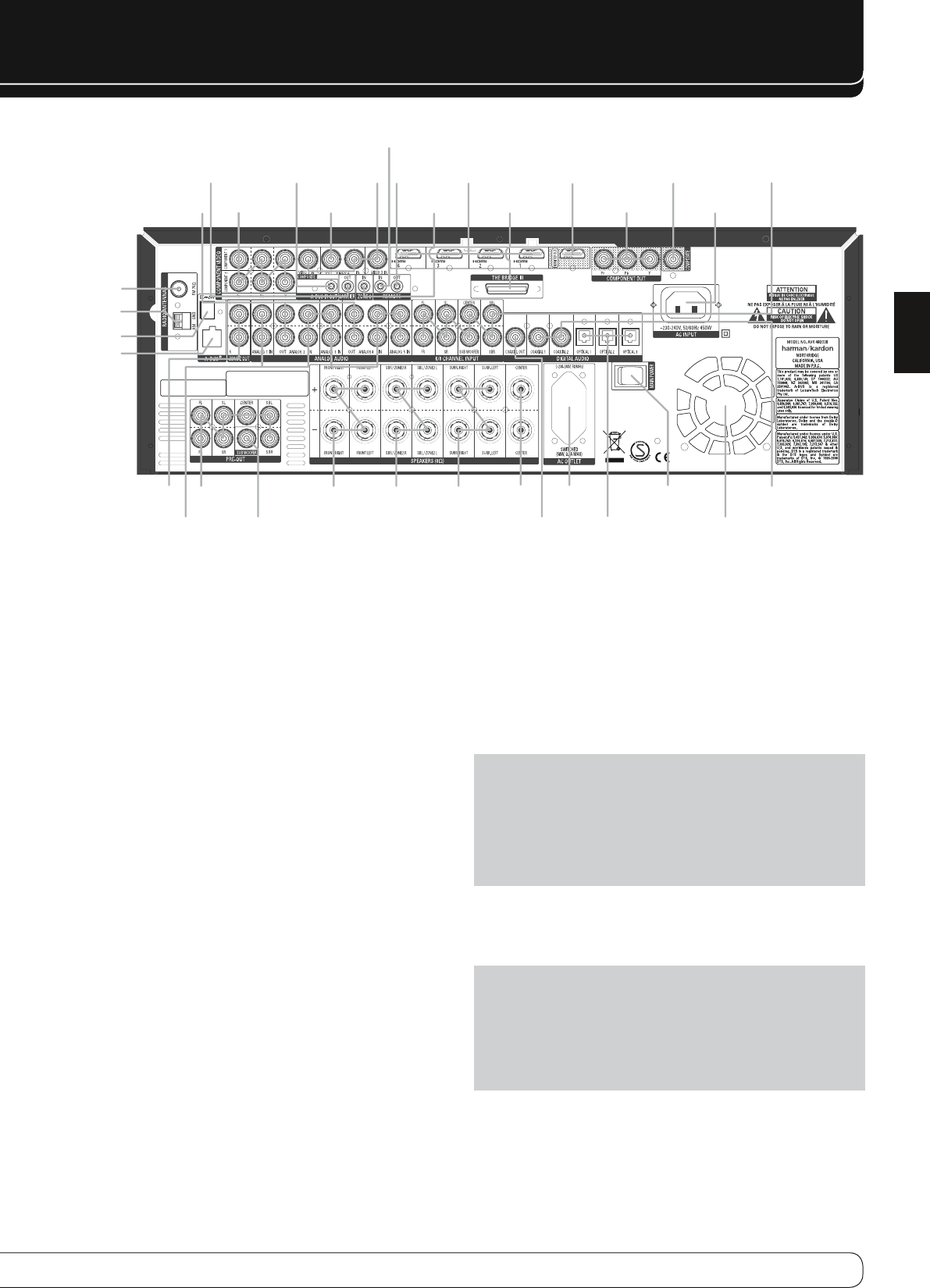
9
ENGLISH
Coaxial Digital
Audio Output
Subwoofer
Output
Analog 1-5
Inputs
Fan Vents
Optical 1-3
Digital Audio
Inputs
(AVR 360: Optical
1-2)
Analog 2 & 4 Outputs
Video 2
Output
Component
1-2 Inputs
The Bridge III
Zone 2
IR Input
Component Video
Monitor Output
AC Power
Input
REAR-PANEL CONNECTIONS
Main Power Switch
: This mechanical switch turns the power supply on
or off. It is usually left on, and cannot be turned on or off using the remote
control.
6-/8-Channel Inputs
: Connect the multichannel analog audio outputs
of a non-HDMI player (DVD-Audio, SACD™, Blu-ray Disc™ or HD-DVD, or any
other external decoder) to these jacks.
Coaxial 1/2 and Optical 1/2/3 Digital Audio Inputs
: If a source
has a compatible digital audio output, and if you are not using an HDMI
connection for audio for the device, connect it to one of these jacks to hear
digital audio formats, such as Dolby Digital, DTS and linear PCM. Use only one
type of digital audio connection for each source.
Coaxial Digital Audio Output
: If a source is also an audio recorder,
connect the Coaxial Digital Audio Output to the recorder’s matching input for
improved recording quality. Only PCM digital audio signals are available for
recording. Both coaxial and optical digital audio signals are available at this
Digital Audio Output.
Zone 2 Infrared (IR) Input
: Connect a remote IR receiver located in the
remote zone of a multizone system to this jack to control the AVR (and any
source devices connected to the Remote IR Output) from the remote zone.
Remote Infrared (IR) Input and Output
: When the remote IR
receiver on the front panel is blocked, connect an optional IR receiver to the
Remote IR Input jack. The Remote IR Output may be connected to the Remote
IR Input of a compatible product to enable remote control through the AVR.
Remote IR Carrier Output(AVR 460 only)
: This output is similar in
function to the Remote IR Output, with the difference that this jack outputs
the full infrared signal as received by the AVR’s IR sensor or the Remote IR
Input, while the Remote IR Output jack outputs a “stripped” signal that has no
carrier frequency.
HDMI Inputs and Output
: HDMI (High-Definition Multimedia Interface)
is a connection for transmitting digital audio and video signals between
devices. Connect up to four HDMI-equipped source devices to the HDMI inputs
using a single-cable connection.
When you connect the HDMI Output to your video display, the
AVR 460/AVR 360 will automatically transcode analog video signals to the
HDMI format, upscaling to as high as 1080p.
NOTES
: When connecting a DVI-equipped display to one of the HDMI
Outputs:
Use an HDMI-to-DVI adapter. •
Make sure the display is HDCP-compliant. If it isn’t, do not connect it to •
an HDMI Output; use an analog video connection instead.
Always make a separate audio connection. •
Analog 1 – 5 Inputs
: Connect the left and right analog audio outputs of
a source device to any of these inputs. These inputs may be paired with any
video inputs.
NOTES
:
The Analog 2 and 4 inputs are each associated with a set of outputs.
Consider using these connectors for an audio or video recorder.
You may optionally connect a source to both an analog and digital audio
input. This is useful for making recordings, for multizone applications or
simply as a backup.
Main
Power
Switch
6-/8-Channel Inputs
Remote IR
Output
Coaxial 1-2 Digital Audio Inputs
Preamp
Outputs
(AVR 460 only)
Surround
Back/Zone 2
Speaker
Outputs
FM Antenna
AM Antenna
Zone 2 Audio Outputs Surround
Speaker
Outputs
Front Speaker
Outputs
A-BUS Port
A-BUS on
AVR 460 only
A-BUS Power Input
HDMI 1-4
Inputs
HDMI Monitor
Output
Remote IR Input
Carrier IR Output
(AVR 460 only)
Video Monitor
Output
Switched AC
Accessory
Outlet
Center
Speaker
Outputs
A-BUS IR
Output
(AVR 460 only)
Video
1-3 Inputs


















